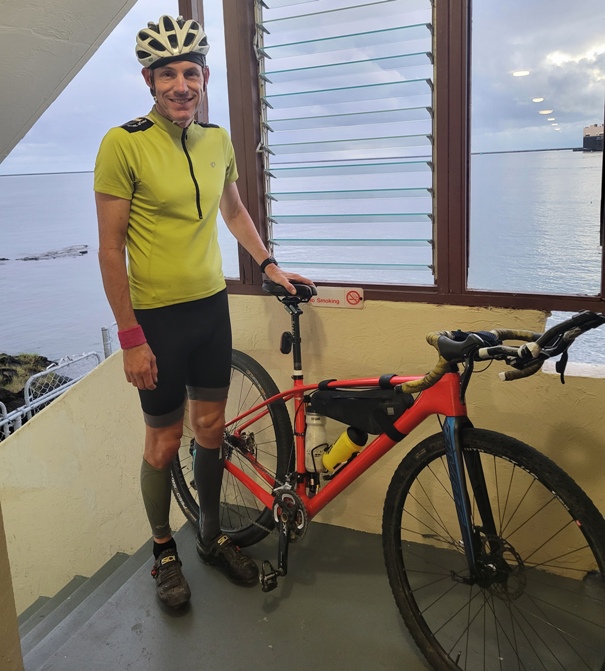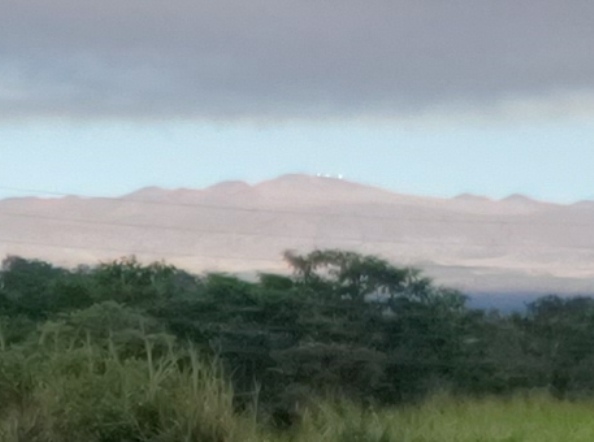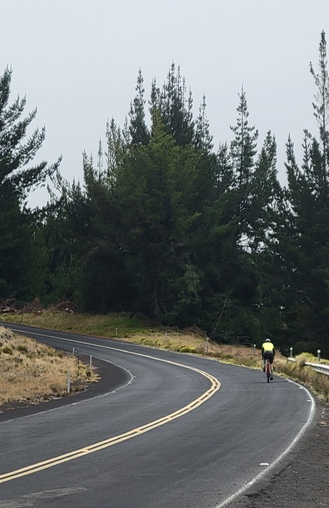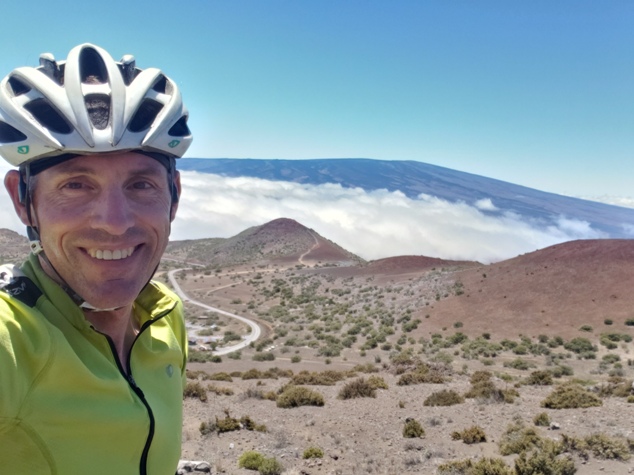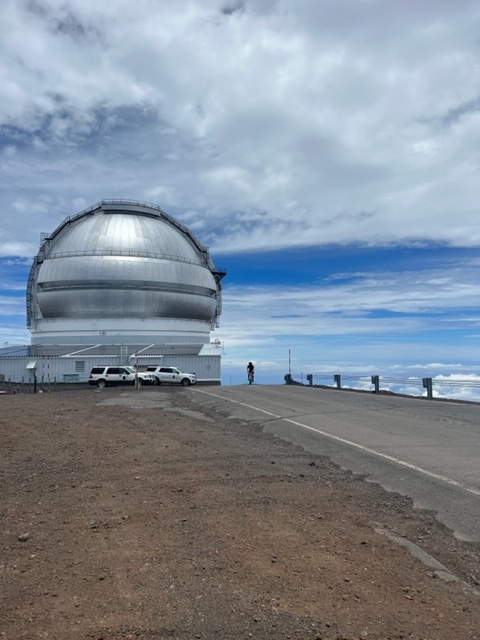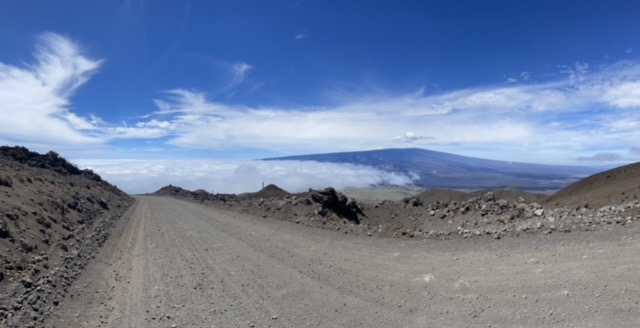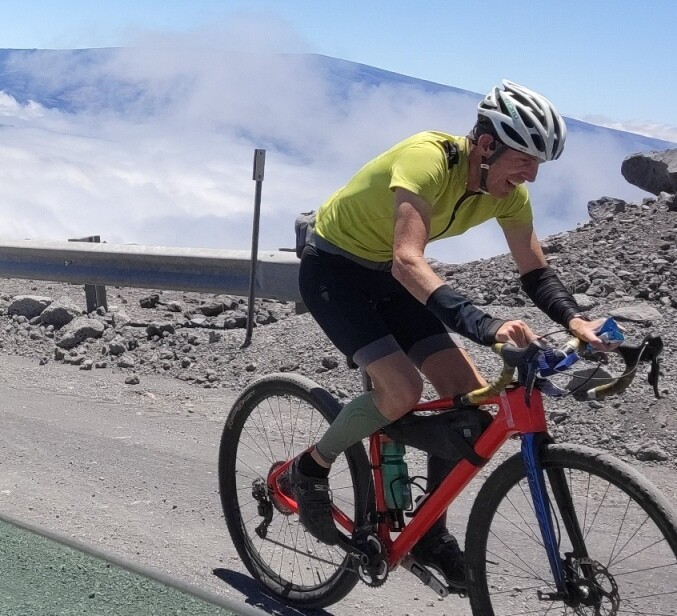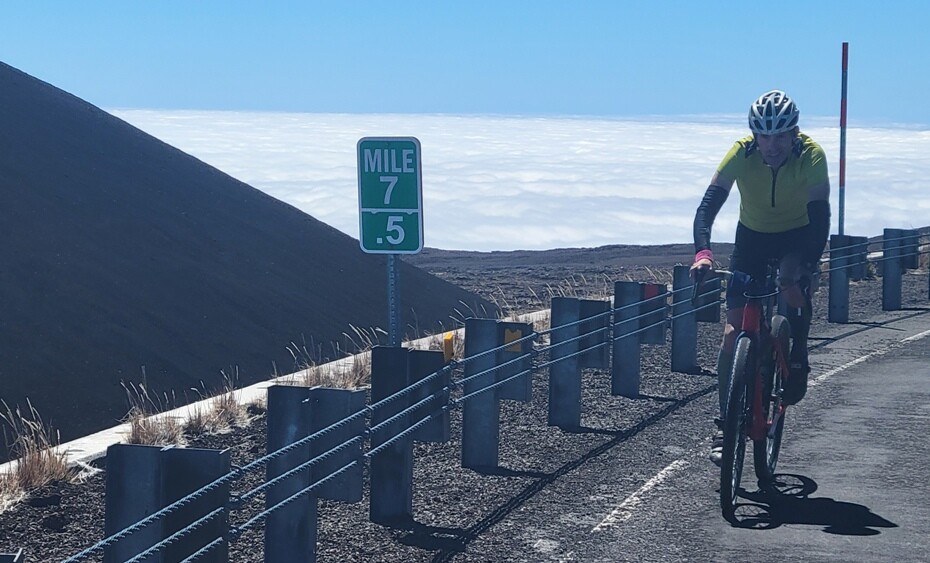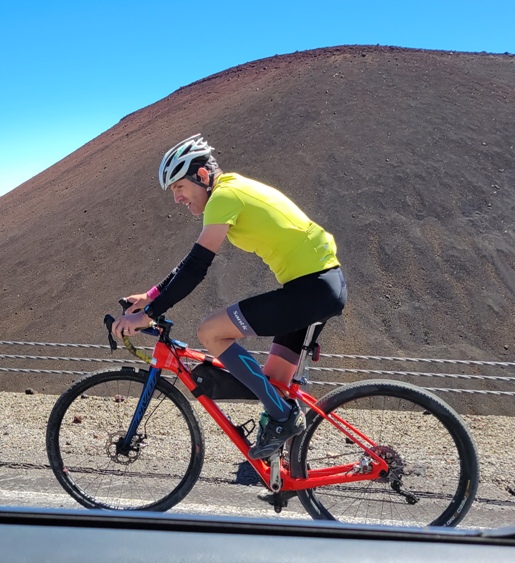Riding Mauna Kea
If you have never been to Hawaii or the big island before, you quickly realize that every point on the island is sloping down from one volcano or another. Flying in, you could see Mauna Loa and Mauna Kea and they dominate the landscape. The other thing you learn pretty quickly is that there are always clouds somewhere, usually up hovering like a ring around the volcano peaks.
The night before I rode up, we went to dinner and for just a moment you could see a break in the clouds that revealed the summit. It looked far away and very intimidating.
On the morning of my ride, I took the bike out and it was humid and cool but not raining and I started off feeling good and looking forward to the new sights and challenge of the day. Once on the main road, there was a big shoulder and plenty of space and at no point did I feel uncomfortable about the traffic. The climbing starts immediately from the road near the bay and the water, though it is quite irregular as it follows the contours of the volcano. For the most part, it averages between 4 and 6 percent but the grades are more like 7-8 percent when you are climbing and then 1-2 percent as you crest a rise. As such, patience is your friend and I had a target wattage around 150 low down the mountain to save for later. With cloud cover it was very pleasant and after an hour the peak popped out for a bit so you could see where you were going.
The previous day when I had sent my children a picture, my son had told me it looked “like a place guarded by orcs and ruled by a Dark Lord.†I was proud of his reference and we exchanged Lord of the Rings jokes the rest of the climb.
Despite not feeling like a particularly arduous climb, you keep gaining altitude until at about 6,000 feet it starts to level off a bit in the saddle between Maua Loa and Manua Kea. My climbing/easy gravel bike has aerobars that were very useful on the flatter, faster sections of the climb, but the dual position seatpost also offered an alternate position to sitting and grinding on the climb, which helped. I hit the turn to the access road at just a hair under 3:30 of riding with the clouds now covering the sky and looming up the climb.
The early part of the access road is pretty easy and by that point I was out of water wondering when my wife would show up when my eating/drinking timer went off and there she was behind me. I grabbed some arm warmers, ditched my aero bars, put on a new, lighter seat/post and proceeded with a minimum of water and fuel. It was probably only 3-4 pounds difference, but when the road tipped it was probably more mental than actual.
And the road did tip up. Just as I entered the clouds it became very steep and I went from averaging 132 to over 150 in a pretty short period of time despite having a very low gear. It eased a bit in a couple of places until I broke through the clouds into bright sunlight and an extended very steep section (17 percent from the sign above) that eased just before hitting the visitors center at 9,000 feet. You have to sign in there and my wife rolled up in the rental Jeep as I was getting ready to leave. (for that section of the access road I averaged 148 watts)
From the visitors center there is a 4.7 mile section of the climb that is on graded gravel. It averages about 10 percent, but was, in reality, steeper and flatter with the worst sections on the big sweeping switchbacks. Here my 46mm front/55mm rear tires really came into there own as did my 24x36/42 low gears.
I stopped to take a pic about the 10,000 foot mark just as my wife rolled up. I was thinking at the time, ‘This is not that bad, really,’ which turned out to be a bit premature. (I was at only 135 or so average watts at that point of the gravel) She mentioned to me that a runner was coming and sure enough, a young stud caught up with me soon and ran next to me for a mile or more. He left me with about .7 to go on the dirt where it became very steep and loose with bad washboards. I started slipping more but only had to push for about one 10-meter section that was too soft. I was quite happy to leave the gravel behind and be back on the pavement. (By the end of the gravel I average high 140s for the 4.7 miles)
The road gives you a short break and then just starts going UP. I encountered the only other cyclist I met on the day, a man from the Netherlands who was being supported by Hilo local Chris, a photographer who offers climb support if you come by yourself. The poor Dutchman had had his bike stolen the day before and was suffering with what looked like a 34x28 or 30. By this point I was solidly in my 24x42 and hurting to get enough air to fight the grade and headwind. I’ve never been more relieved to hit a big switchback and turn with a bit of a tailwind. My wife was waiting on the next switchback and my computer said I had about five hundred feet more to go, so I settled in to suffer. It turned out the way the road was built shielded you from the wind and my altimeter was off, so I was nearly finished. I came around the corner and saw the top and rolled up feeling both relieved and excited that I had made it to the top. In fact, the sense of relief was so great that I spontaneously started to cry and smile at the same time. (I averaged 132 for the last section which was lowered by multiple stops to catch my breath) For the day, my average was 145 watts for 7:15 hours of riding (my Stages reads about 9-10 watts lower than my Powertap). That was a good ten watts more than any of my practice rides, so I timed my peak as well as could be hoped.
At 13,800 feet, you could see far off Maui peaking through the clouds, Mauna Loa across the way and then a sea of white down below.
All in all, I had a perfect weather day and it was just a tremendous day of cycling. Climbing 13,800 feet with only a few false flats requires a lot of patience at my age, but it will certainly be a day I always remember.
For any of you thinking about doing this or who might want to try it, I have a couple of bits of advice.
If you don’t like walking, take the right bike and gearing. I managed my efforts on the day and saved myself for the hard parts by riding conservatively early on and taking advantage of the mtb-like gearing of my all-road climbing bike. I never had to walk because of insufficient gearing. You can also rent an mtb on the island and just use that for the gravel if you are being supported.
Create training days to replicate the effort. In the three weeks that preceded the trip, I used first Onion Valley Rd, then Mt Baldy and then Horseshoe Meadows to simulate 13,000 foot climbing days with the end of those days at high altitude. For the summer, I had seven or eight days over 10,000 feet with a lot of work above 8,000 feet of altitude. If you can’t go that high, then know what you can do for your projected finish time and ride your plan. I knew about how fast I could climb and projected a 7:30 finish time which I bettered by about 15 minutes.
Go with a two or three day window, if possible. I had a perfect day, but I was mentally prepared for rain, tough conditions and even a road closure.
If you are not into an entire day of suffering, just start at the access road. I wanted to climb ‘the world’s toughest climb’ by Fiets score (28.7), but the first 30miles and 6,500 feet are not as interesting or challenging as the last 15 miles of climbing. By itself, those last 15 miles are still tougher than anything you can find in the US, at any of the grand tours and all but the most extreme roads. I think I read that by itself, it ranks #4 in the world.
If you have the time, prepare by riding Haleakala on Maui and Mauna Loa first. The Maui climb is actually #2 in the US and top ten in the world. Mauna Loa is a different kind of climb, but still takes you up pretty high in altitude.
